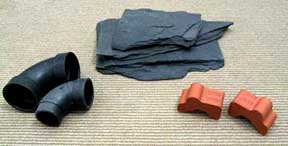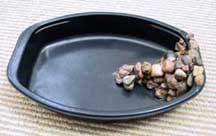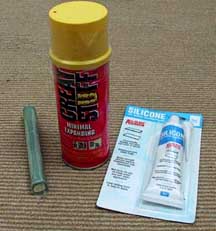Tank Design and Engineering for Newts
This is an area where there is a lot of room for creativity. On this page, I
will list items that can be used for engineering the tank of your dreams (or
your newts’ dreams). On a separate page, I have some pictures of my tanks.
Before you buy...
The first thing you need to consider is: what are the requirements of this
species? Does it need land, and if so, how much? Will it like a current in the
water, or is it happier with no current? Does it need to be kept very cool
year-round, or can it tolerate temperatures into the 70s in summer? The only
way to find these things out for sure is to research the species.
Don't trust the pet shop to tell you what you need to know! Get some books
about newts, get some advice from other keepers, and find out as much as you
can before investing in equipment.
Filters...
What kind of filter works best for newts? Every keeper has their own
favorite. See Filters
for Newt Tanks.

Safe
Stuff for Aquatic Tanks...
- Aquarium products
sold at a pet store. Note that some items sold for reptiles are not made
to sit in water. Do not buy ornaments with hollow spaces where a newt
could crawl inside and not be seen.
- Hard rocks.
Do not use limestone, as it raises the pH of tank water. Instead of the
expensive rocks that some aquarium shops sell, I would recommend getting
rocks from Home Depot or from outdoors. Stores are sometimes willing to
sell small broken pieces of slate for very little (I got a substantial
supply for $3).
- Bricks.
Note that some brick-like objects are made from cast cement (cement block
material), and these should not be used. Cement will raise the pH of tank
water.
- Ceramics,
including clay flower pots. Your local gardening store offers endless
options.
- Hard wood.
For example, a well-weathered piece of freshwater driftwood will be OK.
Cork bark makes excellent islands. However, some woods will turn the water
brown, and soft woods such as pine should be avoided.
- Plastics.
Here, the possibilities are endless, from food containers to styrofoam to
flower pots. Lego bricks can be assembled to use as supports under other
items, or as floating rafts.
- Glass, Plexiglass,
and Lexan. Glass shops and home improvement stores will cut
pieces to whatever size you need. I paid $5 for a piece of glass about
5x12 inches with nicely smoothed edges.
Safe Stuff for terrestrial tanks...
- Top soil. Buy
the plainest kind, not potting soil or potting mix. You can also get it
from outdoors, of course. If you are worried about parasites, you can bake
it before using.
- Gravel,
from a pet shop, home improvement store, or outdoors.
- Aquarium charcoal
or carbon. Used as a bottom layer, helps with drainage and controls odors.
- Dry moss.
Can be either the horticultural kind or the pet store kind.
- Coconut fiber
products. These include Bed-a-Beast and Coco Chips.
- Live moss,
either from outdoors or from mail order places.
- Leaves and twigs.
Can be easily replaced when they begin to decay.
Building your own aquarium decorations...
- Kiln-fired clay.
You can build anything out of this, but you need to have access to a kiln.
Some art stores and do-it-yourself pottery places offer this service. You
can use pieces with or without glazing. Choose a natural low-fire clay or
terracotta.

- Aquarium silicone
sealant. Can be used to stick together rocks and gravel into any
desired shape. Sticks especially well to glass and rocks, but sticks
poorly to plastic.
- Epoxy putty.
Dries hard and paintable. More resistant to breakage than clay is. Small
amounts of aquarium-safe putty can be bought at some on-line pet stores
(such as thatpetplace.com) and these can even be applied and harden underwater.
Non-aquarium putties should be allowed to cure thoroughly before putting
them into an aquarium.
- Glue gun.
This glue is safe and non-toxic, even in water. The big advantage is that
it hardens immediately so there is no curing time required. The
disadvantage is that it does not hold very well in water, and does not
adhere well to glass.
- Great Stuff expanding
foam. This is sold in spray cans at hardware stores, usually in the
insulation department. It’s messy to work with, but completely safe
when it hardens. Can be sealed with epoxy sealant and/or painted. Some
pond stores sell black expanding foam.
- Fiberglass.
This is also completely aquarium safe when dry, but has toxic fumes and is
messy to work with.
- Paint.
Most paints, both latex and oil-based, are safe to use as long as they are
allowed to completely cure. Allow at least twice the recommended drying
time.
Additional tips and suggestions...
- When using
"wild-caught" rocks, bricks, leaves, wood, etc., you can boil
or bake them before putting them in your tank. This will prevent the
spread of any parasites or germs, and also help to loosen embedded dirt
before it goes in your tank. Be careful with baking (300F for one hour), some
rocks can explode when baked, and some items may brown or even ignite.
- You can create "extra
space" in your tank by making it a multi-level affair. This can be
accomplished by installing a horizontal shelf, or putting in large flat
pieces of rocks at various levels. In this way, you can still use the
whole tank for water space, but also have a land area.
Last edited January 4, 2004
© Jennifer Macke